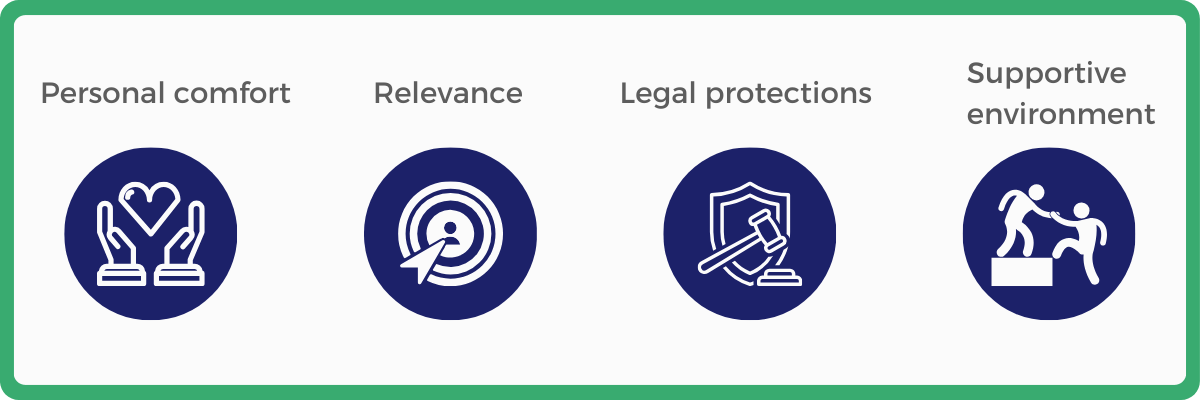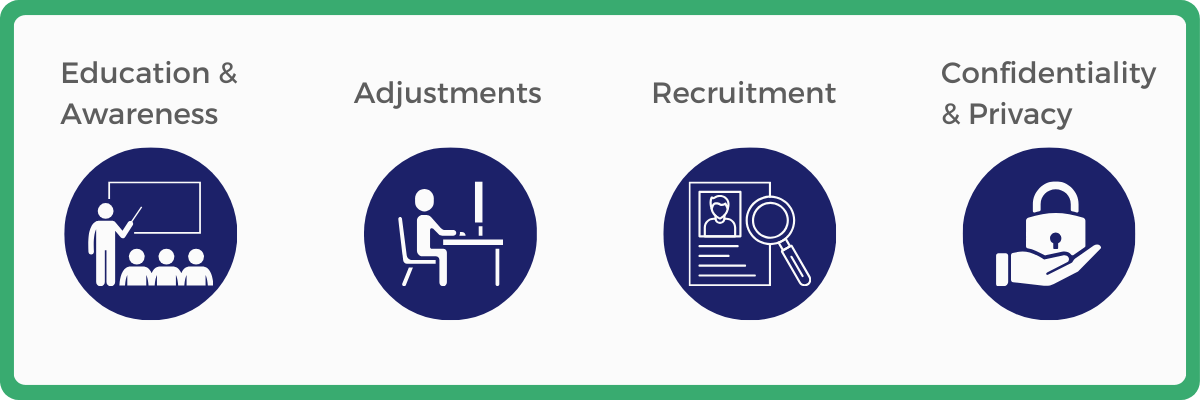Embracing Your Neurodiversity: The Case for Openly Sharing Neurodifferences
Sharing neurodifferences is a dilemma faced by many neurodivergent individuals, and a question they may ask themselves is if they should share their neurodifference with current and prospective employers. When it comes to openly sharing neurodifferences, research has found:
73% of respondents to a survey carried out by Made by Dyslexia (2017) said that they hide their dyslexia from employers.
A report by City & Guilds, (2023) found 32% of neurodivergent individuals said they did not feel able to share their neurodifferences at work.
70% of autistic adults reported by FE News said that they do not share over fears of discrimination and being treated unfairly.
According to Acas, approximately 1 in 7 individuals in the UK are neurodivergent. This is over 9 million people, which is about 15% of the workforce. This shows that there is a clear need for professionals to understand and educate themselves around neurodiversity in the workplace, to ensure that the appropriate support can be put in place for individuals to feel comfortable enough to share their neurodifferences. This blog highlights what the impact of sharing a neurodifference can be to a neurodivergent individual, to help them make a decision when faced with the dilemma of sharing or not.
Neurodivergent individuals can possess many unique strengths and talents, such as creativity, big picture thinking, resilience and strong problem-solving skills. These skills can be highly beneficial in the workplace, and in personal settings.
What is Neurodiversity?
Neurodiversity refers to the concept that neurological differences, such as dyslexia, developmental coordination disorder (DCD)/dyspraxia, dyscalculia, autism spectrum conditions (ASC) and attention deficit hyperactivity disorder (ADHD), are simply natural variations of the human brain relating to how individuals think, interact, and perceive the world around them. It is crucial for employers to acknowledge and embrace neurodiversity to foster an inclusive and diverse work environment.
Should I Share My Neurodifference?
Now, let us delve into the advantages of sharing one's neurodifference. First and foremost, this can foster a more inclusive and understanding work environment. By openly sharing their neurodifference, individuals can educate their colleagues and supervisors about their skills and talents, specific needs, adjustments, and work styles, reducing misunderstandings and promoting effective communication. This increased understanding can lead to a more equitable and supportive workplace culture for neurodivergent individuals.
Another question often asked is if sharing would help increase chances of securing and retaining a job. Ohl and colleagues (2017) in a study with autistic adults, found that those who openly shared their autism to their employer, were three times more likely to be currently employed, compared to those that did not. This retention could have been due to workplace adjustments provided, or autistic adults being made to feel included and motivated to remain with their employer.
Sharing can lead to appropriate workplace adjustments. When individuals share that they are neurodivergent, it enables organisations to provide necessary adjustments and support, such as flexible work hours, quieter workspaces, or access to assistive technologies. These adjustments not only improve the well-being and productivity of neurodivergent individuals, but also contribute to a more inclusive and diverse workforce overall.
Masking or camouflaging is another factor to consider when deciding to share neurodifferences (which is a strategy used by some individuals to hide their traits to conform to neurotypical, socially accepted behaviour). 70% of autistic adults reported that they constantly mask (Cage & Troxell-Whitman, 2019), this includes forcing themselves to make eye contact during conversation, or experiencing sensory overload and not being able to find a way to move away from the discomfort. Sharing could relieve the strain of hiding one’s traits and could increase the likelihood that the neurodivergent person may find and develop a social support network with others who might have similar experiences.
According to the Harvard Business Review in 2021, employees who were confident to share their needs at work were 30% more engaged with career satisfaction, aspirations, and confidence, and reported a sense of belonging, compared to those who chose not to.
Factors to Consider in Sharing
1. Personal Comfort: Consider your own comfort level with sharing your neurodifference. It is your decision whether to share, and you should only do so if you feel it is necessary or beneficial for your situation.
2. Relevance: Assess the relevance of your neurodifference to the situation at hand. If it directly affects your ability to perform a task or interact with others, sharing may be necessary to ensure appropriate adjustments or understanding, such as getting additional time during a recruitment process if undertaking psychometric tests.
3. Legal Protections: Under the Equality Act 2010, disability is a protected characteristic, and this includes neurodifferences, such as ADHD, autism, and dyslexia etc. This means an employer must consider reasonable adjustments to avoid you being put at a disadvantage. Understanding your rights can help inform your decision on whether to share.
4. Supportive Environment: Evaluate the environment and the people involved. Consider whether the individuals or organisation are likely to be understanding, supportive, and accommodating. Have a look at the organisation to see what their policies are around diversity, equity, and inclusion. This can help you gauge the potential impact of sharing.
5. Potential Benefits: Consider the potential benefits of sharing your neurodifference. It may lead to increased understanding, adjustments, or access to resources that can support your success in various aspects of life.
6. Timing: Determine the appropriate timing for sharing. It may be beneficial to share early on, such as during the interview process, or at the start of a new job, to establish open communication and set expectations.
7. What to say: Some employers may not know about or understand neurodiversity, and it is best not to assume. You may need to describe your neurodifference and what support you may need, whether this is for interview adjustments, or support with workplace tasks. You may choose to describe your neurodifference with a strengths-based approach, such as:
“I have dyslexia, which means I think differently and have strengths in creativity, problem solving, good communication skills, lateral thinking and thinking ‘outside the box’. My dyslexia impacts me in reading, writing, spelling and working memory, and I find it helpful to have support in these areas”.
Remember, the decision to share a neurodifference is personal and should be based on your own judgment and assessment of the situation. It can be helpful to seek guidance from trusted individuals or professionals who can provide support and advice tailored to your specific circumstances.
The Potential Impacts of Sharing
On the flip side, unfortunately there are also disadvantages to consider when it comes to sharing. Sharing one's neurodifference may still carry social stigma, misconceptions, and biases. Research suggests that the fear of stigma and discrimination from management and colleagues present a significant barrier to sharing a neurodifference (McDowall et al., 2023).
Some individuals may fear potential discrimination, negative judgments, or even being overlooked for opportunities once their neurodiversity is known. This fear of sharing can create additional challenges in finding acceptance and understanding within the workplace.
Furthermore, sharing may result in unintended consequences, such as being labelled solely based on one's neurodifference. This labelling may overshadow an individual's other skills, qualifications, and contributions, potentially limiting their career growth and opportunities.
How Employers Can Create a Safe Space for Sharing
To create a safe space for individuals with a neurodifference, employers should consider the following steps:
1. Education and Awareness: Ensure that all employees, including management and HR, are trained in understanding neurodiversity. Education can include workshops and webinars, e-Learning, or informational materials to enhance understanding and support.
2. Adjustments: Recognise that neurodivergent individuals may require certain adjustments to thrive in the workplace. Offering diagnostic and workplace needs assessments can support a person to understand their neurodifference and get access to adjustments, such as assistive technology, coaching and workplace support, e.g., flexible working, remote working options, or quiet spaces to minimise distractions and optimise their productivity.
3. Recruitment: Ensuring recruitment practices are neuro-inclusive means organisations are likely to attract a wider talent pool of neurodivergent talent. A study by Text Help found 93% of workers with a neurodifference would be more likely to apply for a job if they knew the organisation is proactive and supports neurodiversity.
4. Confidentiality and Privacy: Create a supportive culture where sharing one's neurodifference is actively encouraged but is also treated with utmost confidentiality. Employees need to feel assured that sharing about oneself will not negatively impact their standing within the organisation. This can be done by ensuring that the HR team is educated around neurodiversity to enable them to have the sensitive conversations and act as an advocate for employees.
5. Open Communication Channels: Establish open lines of communication between employees and Human Resources. This can be done through regular meetings, feedback sessions, or anonymous suggestion boxes to encourage employees to express their needs, concerns, and suggestions in a safe and non-judgmental environment.
6. Support and Training: Provide appropriate support and training for both managers and colleagues to ensure they understand how to effectively communicate and collaborate with individuals with neurodiversity. This can include training sessions on neuroinclusive language, effective communication techniques, and strategies for managing diverse teams.
7. Employee Resource Groups: Consider creating employee resource groups specifically dedicated to neurodiversity. These groups can provide a platform for individuals with neurodiversity to connect, share experiences, and provide mutual support. They also serve as a valuable resource for organisational guidance on fostering a more inclusive and accepting workplace.
By implementing these strategies, employers can foster a positive work environment where neurodivergent individuals feel comfortable in declaring their neurodifference. This will not only empower employees to fully contribute their unique skills and perspectives, but also enhance organisational reputation as an inclusive and socially responsible employer.
In conclusion, whether or not to share one's neurodifference is a personal decision that should be carefully considered. While there are clear advantages, such as fostering inclusivity and obtaining appropriate adjustments, one must also consider potential disadvantages, including social stigma and unintended consequences. It is important for organisations to create a safe and supportive environment that encourages and respects individuals' choices regarding sharing, ultimately leading to a more diverse and inclusive workforce.
To find out how you can create a neuro-inclusive workplace where individuals can thrive, get in touch with our team today.
This blog was written by…





